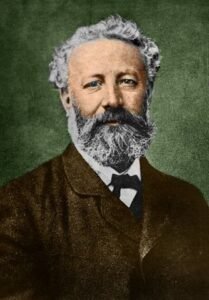Books By Jules Verne
- Five Weeks in a Balloon (1863) – Extraordinary Voyages Series
- A Journey to the Center of the Earth (1864) – Extraordinary Voyages Series
- From the Earth to the Moon (1865) – Extraordinary Voyages Series
- In Search of the Castaways (1867) – Extraordinary Voyages Series
- Twenty Thousand Leagues Under the Sea (1870) – Extraordinary Voyages Series
- Around the Moon (1870) – Extraordinary Voyages Series
- A Floating City (1871) – Extraordinary Voyages Series
- The Adventures of Captain Hatteras (1864-1867) – Extraordinary Voyages Series
- The Children of Captain Grant (1867-1868) – Extraordinary Voyages Series
- Hector Servadac (1877) – Extraordinary Voyages Series
- The Begum’s Millions (1879) – Extraordinary Voyages Series
- The Steam House (1880) – The Steam House Series
- Eight Hundred Leagues on the Amazon (1881) – Extraordinary Voyages Series
- The Green Ray (1882) – Standalone Novel
- The Vanished Diamond (1884) – The Extraordinary Adventures of Founding a New French Colony on the Island of Madagascar Series
- The Archipelago on Fire (1884) – The Extraordinary Adventures of Founding a New French Colony on the Island of Madagascar Series
- Mathias Sandorf (1885) – Standalone Novel
- The Lottery Ticket (1886) – Standalone Novel
- Robur the Conqueror (1886) – Extraordinary Voyages Series
- North Against South (1887) – Standalone Novel
- The Flight to France (1887) – Standalone Novel
- Two Years’ Vacation (1888) – Standalone Novel
- Family Without a Name (1889) – Standalone Novel
- Topsy-Turvy (1890) – Standalone Novel
- Caesar Cascabel (1890) – Standalone Novel
- Mistress Branican (1891) – Standalone Novel
- The Carpathian Castle (1892) – Standalone Novel
- Claudius Bombarnac (1892) – Standalone Novel
- Foundling Mick (1893) – Standalone Novel
- Captain Antifer (1894) – Standalone Novel
- Propeller Island (1895) – Standalone Novel
- Facing the Flag (1896) – Extraordinary Voyages Series
- Clovis Dardentor (1896) – Standalone Novel
- The Sphinx of the Ice Fields (1897) – Extraordinary Voyages Series
- The Mighty Orinoco (1898) – Standalone Novel
- The Will of an Eccentric (1899) – Standalone Novel
- Second Fatherland (1900) – Standalone Novel
- The Castaways of the Flag (1900) – Extraordinary Voyages Series
- The Village in the Treetops (1901) – Extraordinary Voyages Series
- The Sea Serpent (1901) – Extraordinary Voyages Series
- The Kip Brothers (1902) – Standalone Novel
- Traveling Scholarships (1903) – Standalone Novel
- Master of the World (1904) – Extraordinary Voyages Series
- Invasion of the Sea (1905) – Extraordinary Voyages Series
- The Lighthouse at the End of the World (1905) – Standalone Novel
- The Golden Volcano (1906) – Standalone Novel
- The Chase of the Golden Meteor (1908) – Extraordinary Voyages Series
- The Danube Pilot (1908) – Standalone Novel
- The Survivors of the Chancellor (1910) – Standalone Novel
- The Secret of Wilhelm Storitz (1910) – Standalone Novel
- The Barsac Mission (1919) – Standalone Novel
- Backwards to Britain (1989) – Standalone Novel
About Jules Verne
 Jules Verne, born on February 8, 1828, in Nantes, France, was a pioneering French author renowned for his profound influence on the science fiction genre. His imaginative narratives and vivid descriptions of scientific phenomena have captivated readers for generations. Verne’s fascination with exploration, adventure, and the unknown led him to create a vast literary universe filled with submarines, rockets, time machines, and fantastical journeys to the farthest reaches of the Earth and beyond.
Jules Verne, born on February 8, 1828, in Nantes, France, was a pioneering French author renowned for his profound influence on the science fiction genre. His imaginative narratives and vivid descriptions of scientific phenomena have captivated readers for generations. Verne’s fascination with exploration, adventure, and the unknown led him to create a vast literary universe filled with submarines, rockets, time machines, and fantastical journeys to the farthest reaches of the Earth and beyond.
Verne’s upbringing in a seaport town deeply influenced his literary works, fostering his passion for travel and discovery. Although initially trained as a lawyer, his love for writing prevailed, and he embarked on a prolific literary career. His breakthrough came with the publication of “Five Weeks in a Balloon” in 1863, the first installment in his “Extraordinary Voyages” series, which laid the foundation for his future success.
Throughout his career, Verne authored over sixty novels, many of which have become timeless classics of literature. Among his most famous works are “Journey to the Center of the Earth” (1864), “Twenty Thousand Leagues Under the Sea” (1870), and “Around the World in Eighty Days” (1873). His novels often combined adventure with scientific speculation, anticipating future technological advancements such as submarines, helicopters, and space travel.
Verne’s writing not only entertained but also inspired readers to dream and explore the possibilities of the world. His ability to blend scientific knowledge with captivating storytelling earned him international acclaim and made him one of the most widely translated authors in history.
Despite facing initial skepticism from literary critics, Verne’s works eventually gained recognition for their visionary qualities and enduring appeal. Today, he is celebrated as one of the founding fathers of science fiction, whose imagination continues to inspire readers of all ages to embark on their own adventures of discovery. Jules Verne passed away on March 24, 1905, leaving behind a remarkable legacy that continues to shape the literary landscape to this day.

